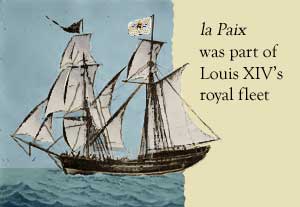Jacques Surprenant dit Sansoucy.
Aboard Le Paix.
Jacques Surprenant hailed from Perche, France, the son of Jacques Surprenant and Louise Roquet. He took the dit name of Sansoucy (carefree) when he joined le régiment de Carignan-Salières. His company was that of capitaine Antoine Pécaudy de Contrecœur. As the Iroquois and the British increasingly launched attacks the men were charged by the King Louis XIV with helping to defend the colony in Québec.

Some troops were transported on merchant ships while others were assigned a space on a ship owned by the King. On 13 May 1665 Contrecœur's soldiers joined the La Colonelle, Maximy, and Saurel companies and boarded the Royal brigantine Le Paix as part of the second group sent across the sea. It sailed with the L'Aigle d'Or and arrived in ville de Québec about 19 August. Both ships set off for the return voyage on 19 September, but Le Paix wrecked in the Saint-Lawrence near Matane on the Gaspé Peninsula never to return to France.
Campaigns.
Contrecœur's men then proceeded to Montréal for billeting during the cold winter. In September the men were charged with assisting with the construction of forts. Five were built to serve as military supply stations and to secure the Richelieu River which used by the enemy to travel into lands claimed by the French.

Fort Saint-Louis (later called Fort Chambly) was built in 1665 and had space within its wooden walls to house the troops. Fort Sainte-Anne, the southernmost post, was constructed on Isle La Motte. The others were Forts Sainte-Thérèse, Jean, and Sorel, which was built on the ruins of Fort Richelieu on Lac Saint-Pierre.
Against the advice of the Marquis de Salières, the governor Daniel de Rémy de Courcelles ordered the regiment into battle in the winter. The men were ill-equipped, without snowshoes, proper footgear or warm blankets. Five hundred soldiers, 200 habitants and Indian allies set out on their ill-fated first campaign on 30 January 1666. They lost their way and came upon the village of Schenectady, which they mistook for a Mohawk settlement. A fierce assault followed during which a passing group of Mohawks joined in to help their allies in the British and Dutch village. The regiment was not yet skilled in the guerilla-type warfare that faced them. They suffered heavy losses, up to 400 by some estimates. Some of the men died in battle while many others perished in the harsh Canadian winter snow.
Their second foray came in the early fall of 1666. Packing light to travel rapidly, the men moved into essentially the same territory they invaded the previous winter. This time the Mohawks evacuated their villages ahead of the attack, thus providing the French troops with an easy opportunity to pillage the food, weapons and other supplies left behind. Though they never engaged the enemy, they gained a strategic advantage when they burned the homes and returned to Québec with a bounty of supplies. By July of the following year treaties were signed with the Iroquois that lasted almost twenty years.
With their mission declared complete in 1668, the soldiers were given an option to settle in Québec. About 450 chose to do so. The men were offered land to farm and it was understood they would be in line to defend the colony from the British and the Iroquois.
- Jetté, René, Dictionnaire généalogique des familles du Quebec des origines à 1730 (Montréal: Les Presses de l'Université de Montréal, 1983)
- https://en.m.wikipedia.org/wiki/Carignan-Sali%C3%A8res_Regiment
- https://www.migrations.fr/Leregimentcarignan.htm
- Brigantine Experiment of Newburyport, 114 tons, built at Amesbury in 1803. From Wikipedia
